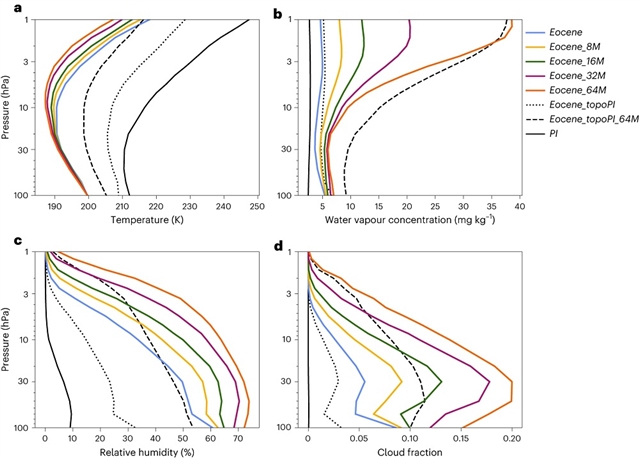
澳大利亚新南威尔士大学Zhu Jiang研究团队近日取得一项新成果。经过不懈努力,他们研究发现始新世早期低地形和高甲烷通过极地平流层云增强了北极变暖。相关论文于2023年11月7日发表于国际顶尖学术期刊《自然—地球科学》杂志上。
小组研究了这些因子主题高顶大气模式与相互作用的化学。早始新世北半球低至中纬度的低地形削弱了平流层环流,加上足够高的甲烷浓度,导致北极冬季极地平流层云的大量增加。
此外,始新世早期极地平流层云的增加是由于甲烷浓度比热前高16- 64倍,导致的辐射强迫大于甲烷本身的直接温室效应。这种极地平流层云引起的辐射强迫可能导致北极表面升温高达7.4 K。这些结果指出了单个作用力之间潜在的非线性相互作用。根据一个具有相互作用化学的大气模型,低区域地形和高大气甲烷水平的间接强迫通过加强极地平流层云的形成,促成了始新世早期北极温度的升高。
研究人员表示,代理数据表明,始新世早期(4780万年前)的特征是赤道到极点的温度梯度比今天弱得多。然而,一般环流模式一直低估了由代理记录显示的高纬度温度,这表明它们可能错过了重要的过程。先前的研究假设,冬季极地平流层云可能通过温室效应强迫在北极变暖中发挥了重要作用,但这些研究没有考虑大气化学或始新世早期地形的影响。
附:英文原文
Title: Early Eocene low orography and high methane enhance Arctic warming via polar stratospheric clouds
Author: Dutta, Deepashree, Jucker, Martin, Sherwood, Steven C., Meissner, Katrin J., Sen Gupta, Alex, Zhu, Jiang
Issue&Volume: 2023-11-07
Abstract: Proxy data suggest that the early Eocene (∼56–47.8 million years ago) was characterized by a much weaker equator-to-pole temperature gradient than today. However, general circulation models consistently underestimate high-latitude temperatures indicated by proxy records, suggesting that they may miss important processes. Previous studies hypothesized that wintertime polar stratospheric clouds may have played an important role in Arctic warming through greenhouse forcing, but these studies did not consider the effects of atmospheric chemistry or the early Eocene topography. Here we examine these factors using a high-top atmospheric model with interactive chemistry. The lower orography in the low- to mid-latitude Northern Hemisphere early Eocene weakens the stratospheric circulation which, in combination with sufficiently high methane concentrations, leads to a substantial increase in polar stratospheric clouds in the Arctic winter. Furthermore, an increase in early Eocene polar stratospheric clouds due to a 16- to 64-fold higher than pre-industrial methane concentration results in a radiative forcing larger than the direct greenhouse effect from the methane itself. This polar stratospheric cloud-induced radiative forcing could cause up to 7.4 K of Arctic surface warming. These results point to the potential for nonlinear interactions between individual forcings. Indirect forcing by low regional orography and high atmospheric methane levels contributed to the amplified Arctic temperatures in the early Eocene by enhancing polar stratospheric cloud formation, according to an atmospheric model with interactive chemistry.
DOI: 10.1038/s41561-023-01298-w
Source: https://www.nature.com/articles/s41561-023-01298-w
